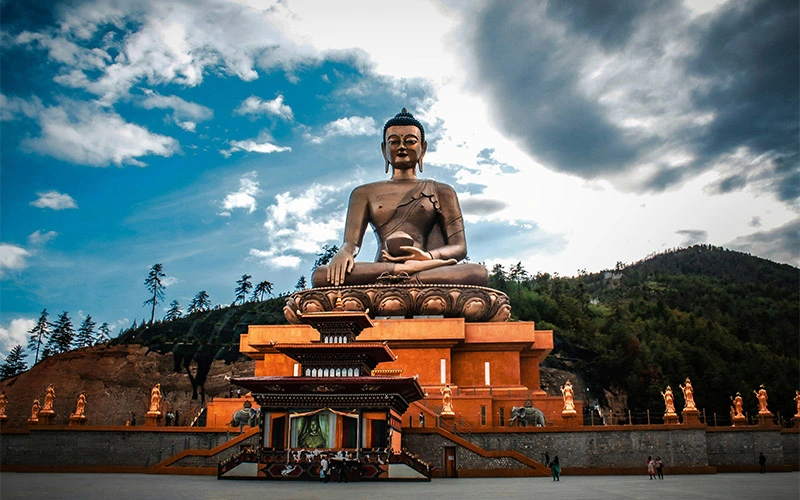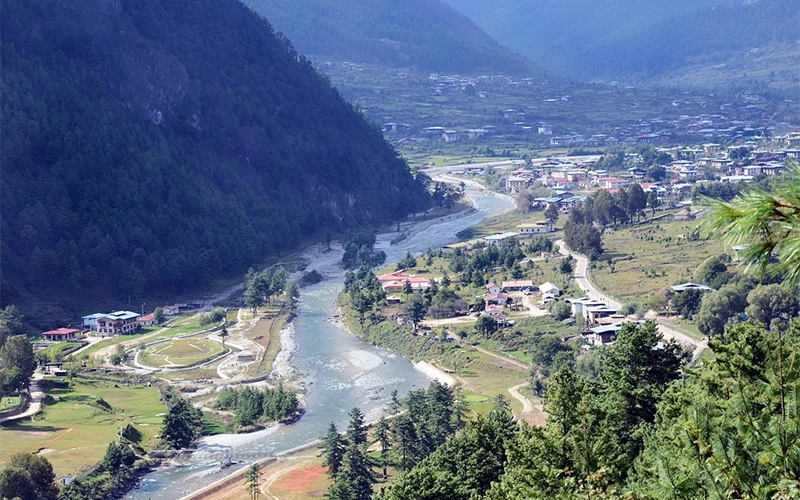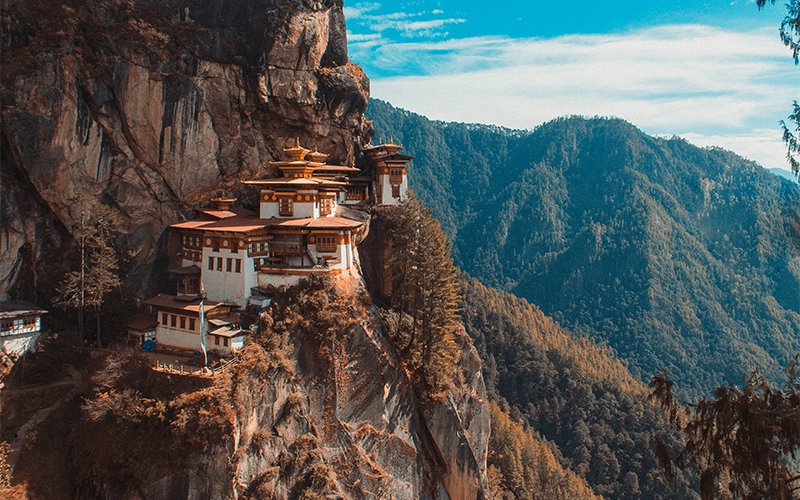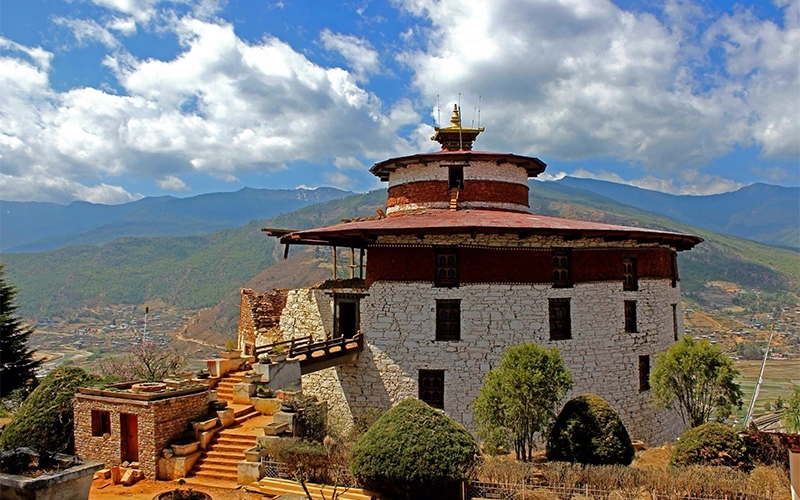Paro, an ancient and picturesque valley in Bhutan, is renowned for its religious and sacred sites, beautiful landscapes, and the majestic Himalayan Range. The best time to visit Paro largely depends on the type of experience you’re looking for. Here’s a detailed guide on the best seasons and months to plan your trip to this scenic valley.

Spring (March, April, and May): The Best Time to Visit Paro
Spring in Paro brings out the valley’s charm with blooming rhododendrons and colorful flowers. The pleasant climate and comfortable temperature (ranging from -3°C to 23°C) make it an ideal time for outdoor activities and sightseeing. The clear skies provide perfect views of the Himalayan range, and this is also the season when Paro celebrates its famous Paro Tshechu festival. Visitors can enjoy cultural performances, religious dances, and vibrant street festivals. The spring season also allows you to indulge in fresh local fruits and witness the valley’s lush beauty.
Highlights:
– Rhododendron blooms and vibrant flowers
– Paro Tshechu Festival with cultural events
– Ideal temperatures for sightseeing
Autumn (September, October, and November): A Pleasant Time to Visit Paro
Autumn in Paro is equally charming, offering clear blue skies and a mild climate (temperatures ranging from 7°C to 23°C). The trees shed their leaves, and the valley takes on hues of red, orange, and gold, creating a breathtaking landscape. Although rainfall can be unpredictable, the occasional showers clear up quickly, ensuring good visibility of the surrounding Himalayan peaks. The autumn months are ideal for trekking and outdoor activities.
Highlights:
– Crisp and clear weather
– Colorful foliage of autumn leaves
– Great visibility of the Himalayan range

Winter (December, January, and February): A Beautiful Yet Cold Time to Visit Paro
Winter brings a tranquil and serene vibe to Paro, though it can get very cold. Daytime temperatures typically stay around 9°C, while the nights can be freezing, dropping to an average of -1°C. Snowfall is common from mid-January to February, giving the valley a picturesque white coat. This season is especially appealing to those who enjoy snow activities or a peaceful retreat. Though it’s cold, the landscapes covered in snow offer a unique and stunning beauty.
Highlights:
– Snow-covered landscapes
– Peaceful and quiet ambiance
– Ideal for those looking for winter activities and snow experiences
Summer (June, July, and August): A Decent Time to Visit Paro
Summer is the monsoon season in Paro, and though the valley becomes lush and green, it’s not the best time for outdoor activities. Frequent rain showers and the risk of mudslides may hinder movement in the valley. However, the rainfall does offer a chance to enjoy the clean air and stunning views of the surrounding mountains. If you don’t mind the rain and occasional disruptions, summer can also be an affordable option for traveling, as many hotels and services offer discounts during this off-season.
Highlights:
– Lush green landscapes and vibrant nature
– Discounts on hotels, tours, and services
– Fewer tourists, offering a more secluded experience
Suggested Itinerary for Visiting Paro, Bhutan
Here’s a detailed itinerary that covers the highlights of Paro and its surrounding areas over several days:
Day 1: Arrival in Paro and Sightseeing
– Arrival in Paro: Fly into Paro Airport, one of the most scenic airports in the world, surrounded by towering peaks.
– Explore Paro Dzong: Visit the majestic Rinpung Dzong, a fortress-monastery with historical and religious significance.
– Kichu Lhakhang: Visit this sacred temple, one of the oldest in Bhutan.
– Evening at Leisure: Stroll around the vibrant town of Paro, enjoy local Bhutanese cuisine, and relax.
Day 2: Hike to Tiger’s Nest Monastery (Paro Taktsang)

– Tiger’s Nest Monastery Hike: Begin your day with a thrilling hike to Taktsang Monastery, perched on a cliffside. It is one of the most iconic landmarks in Bhutan and offers breathtaking views of the Paro Valley.
– Lunch at the Cafeteria: Mid-way through the hike, stop for lunch at a small cafeteria with panoramic views.
– Return and Relax: After the hike, head back to your hotel and relax after an exhausting yet rewarding day.
Day 3: Paro Valley and Surroundings

– Drukgyel Dzong: Start your day by visiting the ruins of Drukgyel Dzong, a historic fort that once defended Bhutan against Tibetan invasions.
– Visit to the Local Market: Spend some time at the local market, shopping for souvenirs, Bhutanese handicrafts, and traditional items.
– Enjoy Traditional Bhutanese Cuisine: Savor a traditional Bhutanese meal with local delicacies.
– Optional Visit to the National Museum: If time permits, explore the National Museum of Bhutan for insights into Bhutanese art, culture, and history.
Day 4: Excursion to Chele La Pass and Haa Valley
– Chele La Pass: Take a scenic drive to Chele La Pass, the highest motorable point in Bhutan, offering panoramic views of the Himalayan range.
– Haa Valley: Visit the beautiful Haa Valley, known for its pristine nature and charming landscapes.
– Return to Paro: Drive back to Paro for an evening at leisure.
Day 5: Departure from Paro
– Departure: After breakfast, head to Paro Airport for your departure, carrying memories of your amazing Bhutan trip.
This itinerary ensures you experience the best of Paro, from its spiritual sites to its natural beauty and thrilling hikes. It also allows enough time to relax and immerse yourself in the peaceful Bhutanese culture.

